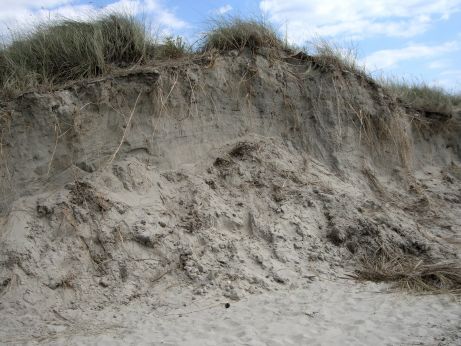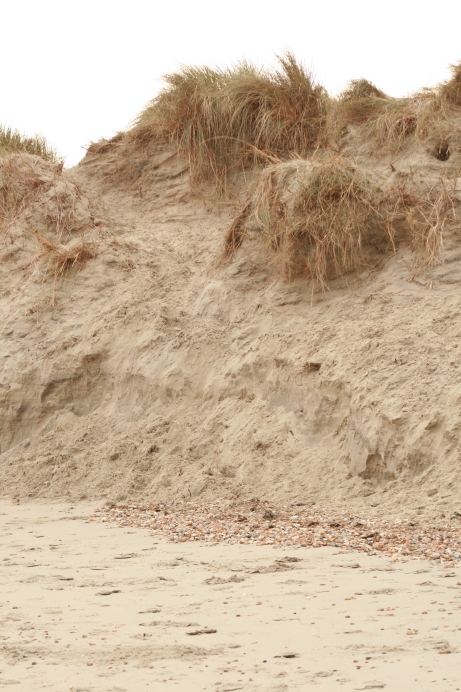Sand dunes are small ridges or hills of sand found at the top of a beach, above the usual maximum reach of the waves. They form from wind blown sand that is initially deposited against an obstruction such as a bush, driftwood or rock. As more sand particles are deposited the dunes grow in size, forming rows at right angles to the prevailing wind direction. If vegetation, such as Marram Grass and Sand Couch, begins to grow on the dune its roots will help to bind the sand together and stabilise the dunes.
Sand dunes can be important ecosystems supporting unique plant life and a healthy population of small animals and insects. An example of a sand dune ecosystem is found at West Wittering on the South East coast of the UK.
Dunes are very vulnerable to erosion by natural processes and by human activity. It is common to see vulnerable sections of dunes fenced off to prevent public access, or for paths to be laid to prevent people from eroding the dunes.
Sand dunes are sometimes found at the top of beaches, above the high tide mark, but not every beach has dunes. For dunes to form there must be a supply of sand, a means of transporting it, and somewhere for it to be deposited more quickly than it is eroded. |
|
When the dried sand reaches the top of the beach it can be trapped by debris such as driftwood, dead seaweed or rocks and pebbles as in this photograph. If the sand is not eroded again it may become colonised by small plants, or trap other windblown debris, increasing its size and thus trapping even more sand. In this picture the wind is blowing from to right to the left.To the right of the pebble are darker and slightly heavier sand grains, and to the left of it are lighter sand particles being deposited where the force of the wind is broken by the pebble acting as a wind break. |
|
As the dunes grow in size they are able to catch more of the sand blown across them by the wind. |
|
In this picture you can see a well establshed sand dune lying about 100m above the top of the present beach. The dune forms part of several parallel rows of dunes that trap sand blown off the beach. The thick covering of vegetation preserves the dune in two ways. Firstly the roots bind the sand together, and secondly the above ground vegetation traps particles of sand as they are blown over the surface. |
|
 d d |
This is an old dune that has, due to erosion of the dunes infront of it, become exposed to the sea. The front of the dune shows a debris pile consisting of sand that has fallen from the face during the last couple of days. The sea now reaches this dune at the highest tides and erosion will be rapid. Note how the root systems of the grasses are exposed along the top of the dune, showing how they penetrate the sand and bind it together. |  d d |
This is an another old dune that is now being eroded by the sea at high tide. The pebbles and flat sand at the base of the dune show where the last tide stopped. The collapsed sand beyond them is a result of waves undercutting the base of the dune, weakening it and it being unable to support the weight of the sand above it. At the base of a dune there are no plants or roots to bind the sand grains together so the sand is easily eroded by the wind, water and even animals crossing over it. Ten years ago this dune was in the middle of a wide belt of similar dunes over 100m from the high tide mark, but due to rapid erosion there are now very few dunes left at this location.
|
![]()
